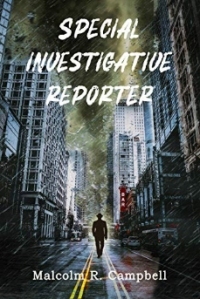Malcolm R. Campbell's Blog, page 47
July 30, 2022
Tootsie Rolls, the “go-to” food for marines fighting in the Korean War.
If you read accounts of the badly outnumbered U.S. Marines fighting against the Chinese near Chosin Reservoir in 1950 in the Korean War, you’ll find the troops constantly eating Tootsie Rolls.
 https://headstuff.org/culture/history/tootsie-rolls-korean-war/
https://headstuff.org/culture/history/tootsie-rolls-korean-war/The temperature was at least -25° and the wind and snow made conditions worse. Cans of C rations, “light” such as fruits and “heavy” such as meats were always frozen and took forever to thaw out in a pot of boiling water over a cooking fire.
“Tootsie Roll” was a code word for a 60mm mortar wound. Running out of ammo, the marines called for a parachute drop. The radio operator didn’t have a code sheet, so sent real Tootsie Rolls.
I don’t know the marines’ first reaction, but the candy (chocolate toffee) became a lifesaver. Unlike frozen cans of food, it would warm up in your mouth, staving off intense hunger and providing energy. It also turned out that a Toosie Roll would plug up a bullet wound in weather so cold that the blood from wounds tended to freeze. The candy, when warmed up in one’s mouth would also work like caulk and patch up leaking fuel lines.
I haven’t eaten a Tootsie Roll in years but had them often as a kid. I wish I’d been able to tell my folks that the candy was “Marine approved.” Of course, I wasn’t doing Korean War research for the novel in progress then, but it seems like the kind of fact that would be mentioned in history class.
July 28, 2022
‘Trailed: One Woman’s Quest to Solve the Shenandoah Murders’ by Kathryn Miles
In an interview in “National Parks Magazine” (Summer 2022) Miles was asked what drew her to research and write about the 1996 unsolved murder case of Julie Williams, 24, and Lollie Winans, 26, near the Shenandoah National Park’s Bridle Trail.
Miles said that she was a contemporary of the victims and a sexual assault survivor who relied upon and felt safe in the backcountry. That two experienced outdoor guides were attacked in an environment that was supposedly safe, “shattered my sense of wilderness and who I was there.”
Jurisdictional and experience issues between the Park Police and the FBI bogged down the investigation, Miles thought. “There was a cultural divide, and there was a procedural divide, between how those rangers did their work, how the FBI did their work, and who was in charge. The FBI didn’t have experience investigating backcountry and wilderness crimes.” You can find the interview and an excerpt here.
From the Publisher“They must have been followed. That’s the thought I return to after all these years . . .
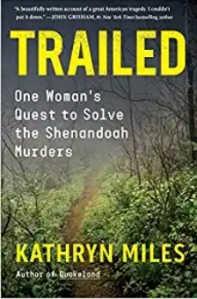 “In May 1996, two skilled backcountry leaders, Lollie Winans and Julie Williams, entered Virginia’s Shenandoah National Park for a week-long backcountry camping trip. The free-spirited and remarkable young couple had met and fallen in love the previous summer while working at a world-renowned outdoor program for women. During their final days in the park, they descended the narrow remnants of a trail and pitched their tent in a hidden spot. After the pair didn’t return home as planned, park rangers found a scene of horror at their campsite, their tent slashed open, their beloved dog missing, and both women dead in their sleeping bags. The unsolved murders of Winans and Williams continue to haunt all who had encountered them or knew their story.
“In May 1996, two skilled backcountry leaders, Lollie Winans and Julie Williams, entered Virginia’s Shenandoah National Park for a week-long backcountry camping trip. The free-spirited and remarkable young couple had met and fallen in love the previous summer while working at a world-renowned outdoor program for women. During their final days in the park, they descended the narrow remnants of a trail and pitched their tent in a hidden spot. After the pair didn’t return home as planned, park rangers found a scene of horror at their campsite, their tent slashed open, their beloved dog missing, and both women dead in their sleeping bags. The unsolved murders of Winans and Williams continue to haunt all who had encountered them or knew their story.
“When award-winning journalist and outdoors expert Kathryn Miles begins looking into the case, she discovers conflicting evidence, mismatched timelines, and details that just don’t add up. With unprecedented access to crucial crime-scene forensics and key witnesses—and with a growing sense of both mission and obsession—she begins to uncover the truth. An innocent man, Miles is convinced, has been under suspicion for decades, while the true culprit is a known serial killer, if only authorities would take a closer look.
“Intimate, page-turning, and brilliantly reported, Trailed is a love story and a call to justice—and a searching and urgent plea to make wilderness a safe space for women—destined to become a true crime classic.”
From Kirkus ReviewsWhat makes this story so chilling is not just that the author had to “police law enforcement” in order to determine their investigative errors. She also shows how “every year there is demonstrable evidence that women, African Americans, and nonbinary and LGBT people have good reason to wonder if they are safe in the wilderness, which in many ways is still considered a white male domain.” Gripping and thoughtful, this book will appeal to those with an interest in true-crime stories and unsettling truths about places deemed safe for all.
Disturbing and provocative.
July 26, 2022
Small press and self-published authors often ask, ‘What’s the point?’
The tales of woe are the same.
A writer works for a year or two on a novel, a small press that’s published his/her earlier work praises and publishes it, Midwest Book Review has kind words for it, his/her followers on Facebook and blog say positive things and click “like” whenever the book is mentioned.
Unlike mainstream authors’ books, the Kindle version of the novel is for sale at 99¢ rather than at a price that’s often higher (initially) than the hardcover edition. The author calls attention to the book’s release by paying Facebook to “boost” posts about it and displays the cover and the plot on his/her blog and website along with notices of any editorial reviews.
After a month or so, the initial hullabaloo of praise from his online friends tapers off. The author is happy none of them asked about sales because they’re in the slim-to-none column of the spreadsheet.
So the author begins to ask “What’s the point?”
His/her disillusionment begins when the hoard of online friends to reacted positively to the book’s cover and the plot never buy a copy. The reader reviews they might have written on Amazon never appear, so the book sits there with only 2-3 reviews months after the release date.
 This guy looks crazy. That’s why he writes.
This guy looks crazy. That’s why he writes.
These online friends aren’t broke. They talk about buying mainstream books at ten times the price, going out to dinner at expensive restaurants, drinking wine at $25-per 750 ml bottle, and taking trips to high-cost venues. The writer wonders what to expect from strangers when his friends won’t even spend 99¢ for a copy. S/he begins to get angry because s/he has purchased their books and written reviews about them on Amazon and his/her blog.
It’s not surprising that s/he asks those of us who’ve been doing this for a while, “What’s the point?”
They complain that in addition to the absolute apathy from prospective readers, they’re losing money. Boosting Facebook posts, maintaining a website, and posting on a blog cost money. So do research materials purchased while writing the book. Some point at this irony: If a person opens a bicycle shop and runs at a loss for months, most people support a decision to close the shop since it’s not a charity. And yet, under the same conditions, the author is expected to keep on writing and losing money.
“Why is that?” I’m asked. I don’t know. I do know that many of those who say an author has some kind of sacred duty to keep writing at a spiritual and financial loss aren’t depending on writing novels for their incomes. Some have a vested interest because they teach creative writing, edit manuscripts, or work for magazines like “Writer’s Digest” that need prospective authors to stay addicted to hope and words and online courses and subscriptions to the magazine.
Years ago, I wrote a letter to “Writer’s Digest,” asking why every single success story it published in the last several years did not result from the prospective writer learning how to write a better synopsis, an awesome query letter, or from a dedicated approach to markets and their submission criteria. Instead, the successes occurred when an agent moved into the house next door or when a creative writing teacher became a bestselling author. That is, the novice got unexpected help that had more impact than everything the magazine had to offer.
The magazine did not reply, much less publish my letter.
So when I’m asked, “What’s the point?” all I can say is that the gurus say you gotta love it while it bankrupts you and steals your soul.
Most people don’t like that answer. I don’t like it either. If you have a better answer, please send me a telegramme because I want a meaningful response for those asking, “What’s the point?”
As for me, I’m retired and keep writing to avoid being bored.
Malcolm R. Campbell is the author of the dark and sarcastic novel “Special Investigative Reporter.”
July 24, 2022
‘Who knows what evil lurks in the hearts of men?’
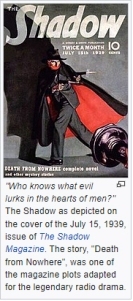 When I was in grade school, everyone knew the answer to this question: “the shadow knows.”
When I was in grade school, everyone knew the answer to this question: “the shadow knows.”
“The Shadow” was a radio drama that aired between 1937 and 1954 with tie-ins to comic books and novels. The show featured crime fighter Lamont Cranston who was a great detective with a few unusual powers. A few films followed the end of radio programs including Alec Baldwin’s in the 1994 version that lost money and wasn’t well received. I no longer remember whether I listened to any radio episodes when I was a kid; it’s possible because when I was home sick from school there was plenty of stuff on the radio to keep my attention.
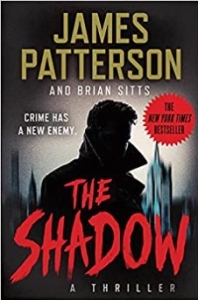 Now James Patterson has bought the rights to the material, kicking off the story with The Shadow (2021) co-written with Brian Sitts. The novel is lightweight fiction compared to Patterson’s Alex Cross series so, while it was fun to read, it was a bit more of a spoof than a hard-boiled detective novel.
Now James Patterson has bought the rights to the material, kicking off the story with The Shadow (2021) co-written with Brian Sitts. The novel is lightweight fiction compared to Patterson’s Alex Cross series so, while it was fun to read, it was a bit more of a spoof than a hard-boiled detective novel.
From the snippets of the radio show I’ve heard, Patterson and Sitts will have to ramp up the action if any sequels are produced for this first one, which has been said to be setting the stage and doesn’t have the ambiance of the original radio series.
So far, the storyline just isn’t edgy enough to hold up as a series. This is the look and the tone I want to see.
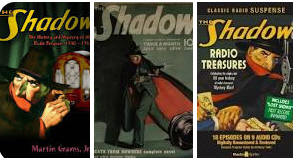
Patterson and Sitts have their work cut out for themselves. “As you sow evil, so shall you reap evil! Crime does not pay…The Shadow knows!”
–Malcolm
July 23, 2022
Everyone wants to know the ‘future’ unless it’s ‘bad’
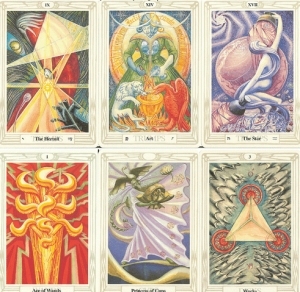 When I used to read Tarot cards and the I Ching, people were simultaneously curious about the future and nervous about hearing what it might be. A person’s feelings about the results of fortune telling were based to a great extent on what exactly they thought the future was/is.
When I used to read Tarot cards and the I Ching, people were simultaneously curious about the future and nervous about hearing what it might be. A person’s feelings about the results of fortune telling were based to a great extent on what exactly they thought the future was/is.
Some people believe in fate, a concrete future stemming from the workings of the cosmos while others believe in destiny stemming from an individual’s probable decisions leading toward a specific or general situation or set of circumstances. I don’t believe in either or that the future is engraved in stone in any way.
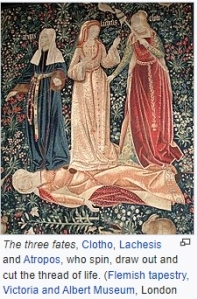 The best point of view I heard about a psychic reading is an old one, one that proposes that a reader is standing on the roof of a tall building viewing multiple city streets that are, of course, not totally visible to people or cars on those streets. S/he sees two cars approaching an intersection without traffic signals. They’re moving a the same speed. One prediction might be that there will be a collision. Yet that prediction is not fixed because either car may change its speed, pull into a parking garage, or stop at a store. The prediction, then, is merely a possibility based on current conditions.
The best point of view I heard about a psychic reading is an old one, one that proposes that a reader is standing on the roof of a tall building viewing multiple city streets that are, of course, not totally visible to people or cars on those streets. S/he sees two cars approaching an intersection without traffic signals. They’re moving a the same speed. One prediction might be that there will be a collision. Yet that prediction is not fixed because either car may change its speed, pull into a parking garage, or stop at a store. The prediction, then, is merely a possibility based on current conditions.
Some say that the future is part of (or all of) God’s plan and that He/She moves in mysterious ways. The Presbyterians used to believe in predestination about not only the future in this world but whether or not we’d end up in heaven or hell in the world to come. The outcome was considered fixed. I was a Presbyterian in my K-12 years and thought that belief was silly. Later, Kabalistic studies convinced me there was nothing mysterious about the workings of the Creator.
Some say all time is now. Everything thing that will happen is happening at this moment in one venue or another. We just can’t observe all the venues with our physical senses. Lena, the cat in my Florida Folk Magic Series, has this view.
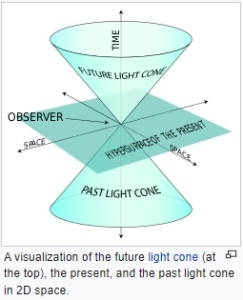 Some quantum physicists say that everything that can happen, will happen in one universe or another. This tends to be my view because I believe we create our own reality. That is to say, the future is what we are creating unconsciously (usually). A lot of people subscribe to this idea in a speculative sense but deny it when it’s applied to real conditions. They don’t want to believe that if they’re in one of the two cars the psychic sees from the roof of the tall building, they have chosen to be in the collision if there is one.
Some quantum physicists say that everything that can happen, will happen in one universe or another. This tends to be my view because I believe we create our own reality. That is to say, the future is what we are creating unconsciously (usually). A lot of people subscribe to this idea in a speculative sense but deny it when it’s applied to real conditions. They don’t want to believe that if they’re in one of the two cars the psychic sees from the roof of the tall building, they have chosen to be in the collision if there is one.
That notion is counter-intuitive and/or horrifying when you get down to specifics and so people think it’s easier to say that God, fate, destiny, luck, or randomness determines the future rather than to say one has any responsibility for it. Personally, I want the responsibility and find that much more palatable than disagreeing with Einstein and believing that God does play dice with the universe. You won’t be surprised to hear that I never express this belief in public after a tragedy because that would shake up the belief system of another person who is suffering a loss.
In fact, most of the time, it’s just better for me to keep my mouth shut except in “what-if?” posts like this one where many readers will just assume I got into the locoweed again.
 Malcolm R. Campbell is the author of the Florida Folk Magic Series, including the novel “Lena.”
Malcolm R. Campbell is the author of the Florida Folk Magic Series, including the novel “Lena.”
July 22, 2022
New: ‘The Mysterious Composition of Tears,’ a novel by Sharon Heath
Thomas-Jacob Publishing has released the latest addition to Sharon Heath’s The Fleur Trilogy, The Mysterious Composition of Tears (July 18). Currently available in Kindle and paperback, The novel book follows History of My Body, Tizita, and Return of the Butterfly.
From the Publisher:
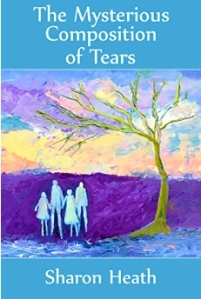 After a series of climate calamities, physicist Fleur Robins takes off for deep space in a desperate attempt to save the species from extinction. During her mysteriously prolonged absence, the internet has crashed, fire and flood have devastated whole countries, and End of Times cults have proliferated. There have been some intriguingly hopeful changes, too—nanoparticle holograms have replaced electronic devices, young people are witnessing exquisitely colorful “Shimmers,” and the most gifted of them converse regularly with animals and trees.
After a series of climate calamities, physicist Fleur Robins takes off for deep space in a desperate attempt to save the species from extinction. During her mysteriously prolonged absence, the internet has crashed, fire and flood have devastated whole countries, and End of Times cults have proliferated. There have been some intriguingly hopeful changes, too—nanoparticle holograms have replaced electronic devices, young people are witnessing exquisitely colorful “Shimmers,” and the most gifted of them converse regularly with animals and trees.
While Fleur’s distraught husband Adam leads their Caltech physics team in frantic efforts to pinpoint her whereabouts, and Fleur herself plots her return home, their teenaged children Callay and Wolf fall in love with surprising partners. But when the charming son of an End of Times pastor crosses Wolf’s path during a particularly vibrant Shimmer, events are set in motion that will upend everyone’s life and transform planet Earth itself.
 This latest installment of Sharon Heath’s saga of the quirky Nobelist Fleur is simultaneously a vision of what awaits us in a post-Covid world, a wild romp through quantum reality, and a deep sea dive into the dark and light vagaries of the human heart.
This latest installment of Sharon Heath’s saga of the quirky Nobelist Fleur is simultaneously a vision of what awaits us in a post-Covid world, a wild romp through quantum reality, and a deep sea dive into the dark and light vagaries of the human heart.
 Come and join us at the Institute Clubhouse or via Zoom on September 10th at 10:30 a. m. for a book reading and signing by Jungian Analyst Sharon Heath of her sequel to The Fleur Trilogy. Admission is free, but registration is required
Come and join us at the Institute Clubhouse or via Zoom on September 10th at 10:30 a. m. for a book reading and signing by Jungian Analyst Sharon Heath of her sequel to The Fleur Trilogy. Admission is free, but registration is required
Heath is also the author of Chasing Eve.
July 20, 2022
I love spicey soups but need an Alka Seltzer chaser
When I came inside from yard mowing around lunchtime today, I poured a glass of Celtic Ale. Robbie, our indoor/outdoor cat who thinks anything on my TV tray belongs to him, tried to get the glass away from me. So Lesa poured a little in a saucer and he turned his nose up at it like that wasn’t the same stuff I had the glass.
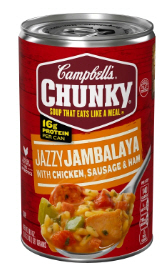 What he does like is the really hot (spicey) Jazzy Jambalaya soup from Campbell’s. I have it with late-night movies but often need an Alka Seltzer as soon as I finish it. If I leave any in the bowl, Robbie jumps up on my TV tray and licks it all up. No chaser. No hairballs. No crazy behavior. What’s wrong with this kitty?
What he does like is the really hot (spicey) Jazzy Jambalaya soup from Campbell’s. I have it with late-night movies but often need an Alka Seltzer as soon as I finish it. If I leave any in the bowl, Robbie jumps up on my TV tray and licks it all up. No chaser. No hairballs. No crazy behavior. What’s wrong with this kitty?
According to Campbell’s website, “This ready-to-eat soup is loaded with antibiotic-free chicken meat, Andouille sausage, rice, and cooked ham, plus veggies and a mixture of flavor-packed spices. Let’s not forget: our fill-you-up soup is also blended with a tasty cayenne pepper sauce that makes it a must-try for any Cajun food fanatic!”
 I love Cajun food, so the soup works for me even though you probably won’t find it on the menu at the Atchafalaya Restaurant in New Orleans. They also serve Creole food, but I won’t hold that against them!
I love Cajun food, so the soup works for me even though you probably won’t find it on the menu at the Atchafalaya Restaurant in New Orleans. They also serve Creole food, but I won’t hold that against them!
At one time, our family had a share or two of stock in Campbells. So, whenever somebody asked if we had anything to do with the soup company, we could shrug and say, “But of course, we do own stock.” But that’s long gone, so I can mention the soup without it being a conflict of interest.
July 19, 2022
Voice-over monologue in film noir
Film noir is famous for its sarcastic, metaphor-filled voice-over monologue that often shows just how cynical the protagonist is about life. I thought of this while re-reading Ruta Sepetys Out of the Easy which gets the style and ambiance of the New Orleans French Quarter just right. I appreciate this line about Willie, the bordello madam: “The voice was thick and had mileage on it.”
One of my favorite lines comes from the former TV series “Early Edition” (1996-2000) about a guy who knows stuff because he gets the newspaper a day early: “The fog was as thick as hash-house oatmeal and twice as cold.”
[image error]Two silhouetted figures in The Big Combo (1955). The film’s cinematographer, John Alton, was the creator of many of film noir’s stylized images. – WikipediaAs “Private Eye Monologue” says, “The signature narration style in Film Noir. A bored-looking, world-weary, the utterly cynical detective (hardboiled and/or defective) with his feet on the desk meets a Femme Fatale, while the voiceover gives us his mental play-by-play:” She walked through my door like a tigress walks into a Burmese orphanage — strawberry blonde and legs for hours. No dame her age could afford a coat like that, and the kinda makeup she had on gave me a good idea how she got it. She had bad news written on her like October of ’29.
The 1946 film “The Big Sleep”(Bogart and Bacall) by Raymond Chandler/William Faulkner, and others, is one of the more enduring noir films because of the stars, author, and director, Howard Hawkes. Chandler’s lines are memorable within the genre: “Dead men are heavier than broken hearts,” “I don’t mind if you don’t like my manners. They’re pretty bad. I grieve over them during the long winter nights,” and “Neither of the two people in the room paid any attention to the way I came in, although only one of them was dead.”
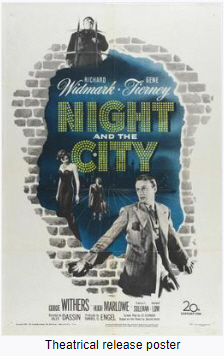 Wikipedia describes Night and the City as “a 1950 film noir directed by Jules Dassin and starring Richard Widmark, Gene Tierney and Googie Withers. It is based on the novel of the same name by Gerald Kersh. Shot on location in London and at Shepperton Studios, the plot revolves around an ambitious hustler who meets continuous failures.” One can’t help but notice: This is like the Greyhound station for DEATH!
Wikipedia describes Night and the City as “a 1950 film noir directed by Jules Dassin and starring Richard Widmark, Gene Tierney and Googie Withers. It is based on the novel of the same name by Gerald Kersh. Shot on location in London and at Shepperton Studios, the plot revolves around an ambitious hustler who meets continuous failures.” One can’t help but notice: This is like the Greyhound station for DEATH!
From “Murder, My Sweet,” we get: “Okay Marlowe,” I said to myself, ‘You’re a tough guy. You’ve been sapped twice, choked, beaten silly with a gun, shot in the arm until you’re crazy as a couple of waltzing mice. Now let’s see you do something really tough—like putting your pants on.’“
From the “Lady from Shanghai”: “Maybe I’ll live so long that I’ll forget her. Maybe I’ll die trying.”
And “Key Largo” “When your head says one thing and your whole life says another, your head always loses.”
According to Wikipedia, “Farewell, My Lovely is a novel by Raymond Chandler, published in 1940, the second novel he wrote featuring the Los Angeles private eye Philip Marlowe. It was adapted for the screen three times and was also adapted for the stage and radio.” I like the 1975 version (classified more as neo-noir) with Robert Mitchum the best: “It was one of those transient motels, something between a fleabag and a dive” and “Moose never would have hurt her. It didn’t matter to him that she hadn’t written in 6 years. It didn’t matter that she turned him in for a reward. The big lug loved her… and if he was still alive… it wouldn’t matter to him that she’d pumped 3 bullets into him… What a world.”
There’s no way to sum all this up except to say that anyone who loves noir has already gone over to the dark side.
–Malcolm
July 17, 2022
Sunday’s who-knows-what’s-in-it HASH
 The oldest of my granddaughters starts high school this fall. In trying to learn more about the place, I visited the website. What a mistake. Seemed Greek to me from the curriculums to the clubs. We had chess club, math club, and physics club. They have clubs like Taylor Swift’s music club which sound more like Facebook groups than H.S. clubs. Sigh. Her school begins with 9th graders, the system I’m used to.
The oldest of my granddaughters starts high school this fall. In trying to learn more about the place, I visited the website. What a mistake. Seemed Greek to me from the curriculums to the clubs. We had chess club, math club, and physics club. They have clubs like Taylor Swift’s music club which sound more like Facebook groups than H.S. clubs. Sigh. Her school begins with 9th graders, the system I’m used to.
 I think I read most of the novels I buy two or three times. This week it’s Kristin Hannah’s
Night Road
. Since it came out so recently, I thought I might remember everything that happens before it happens. But, so far, so good, even after reading this excerpt from the description: “Jude does everything to keep her kids out of harm’s way. But senior year of high school tests them all. It’s a dangerous, explosive season of drinking, driving, parties, and kids who want to let loose. And then on a hot summer’s night, one bad decision is made. In the blink of an eye, the Farraday family will be torn apart and Lexi will lose everything. In the years that follow, each must face the consequences of that single night and find a way to forget…or the courage to forgive.”
I think I read most of the novels I buy two or three times. This week it’s Kristin Hannah’s
Night Road
. Since it came out so recently, I thought I might remember everything that happens before it happens. But, so far, so good, even after reading this excerpt from the description: “Jude does everything to keep her kids out of harm’s way. But senior year of high school tests them all. It’s a dangerous, explosive season of drinking, driving, parties, and kids who want to let loose. And then on a hot summer’s night, one bad decision is made. In the blink of an eye, the Farraday family will be torn apart and Lexi will lose everything. In the years that follow, each must face the consequences of that single night and find a way to forget…or the courage to forgive.”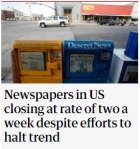 As a journalism school graduate, I found this story in the Guardian discouraging: “Broken and distrusting: why Americans are pulling away from the daily news“ This excerpt sums up the situation: “The Reuters Institute revealed last month that 42% of Americans actively avoid the news at least some of the time because it grinds them down or they just don’t believe it. Fifteen percent said they disconnected from news coverage altogether.” In short, the right thinks the news is untrustworthy and the left is overwhelmed. In recent stories about these trends, some say the growing lack of interest in local news has kicked the foundation out from under the entire medium.
As a journalism school graduate, I found this story in the Guardian discouraging: “Broken and distrusting: why Americans are pulling away from the daily news“ This excerpt sums up the situation: “The Reuters Institute revealed last month that 42% of Americans actively avoid the news at least some of the time because it grinds them down or they just don’t believe it. Fifteen percent said they disconnected from news coverage altogether.” In short, the right thinks the news is untrustworthy and the left is overwhelmed. In recent stories about these trends, some say the growing lack of interest in local news has kicked the foundation out from under the entire medium. When your regular shows are on hiatus, we fall into the depths of nonsense by watching HGTV where people are buying houses with price tags that sound like they belong in San Francisco and/or feature open-plan houses where the entire main floor looks like a gymnasium with little clusters of stuff that remind of my high school’s career day. Many people say they entertain a lot and seem to want a home that reminds them of a cruise ship or a nightclub. We think most of these house plans, to use a technical term, are horseshit, especially when I see that our entire house will fit in the dining room/kitchen.
When your regular shows are on hiatus, we fall into the depths of nonsense by watching HGTV where people are buying houses with price tags that sound like they belong in San Francisco and/or feature open-plan houses where the entire main floor looks like a gymnasium with little clusters of stuff that remind of my high school’s career day. Many people say they entertain a lot and seem to want a home that reminds them of a cruise ship or a nightclub. We think most of these house plans, to use a technical term, are horseshit, especially when I see that our entire house will fit in the dining room/kitchen.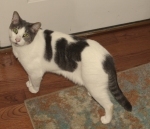 If you have a cat, does it like cantaloupe? Robbie always wants to know what we have on our plates. We tend to eat off of TV trays rather than sitting in the dining room, so it’s easy for him to walk across the furniture to see what we have. He wants to drink out of our water glasses; that causes a tug of war over who gets to hold the glass. Twice lately, I had the rind of a finished cantaloupe on my plate and wondered what he’d do with it. He licked the things for ten minutes. This seems a bit odd. Cats!
If you have a cat, does it like cantaloupe? Robbie always wants to know what we have on our plates. We tend to eat off of TV trays rather than sitting in the dining room, so it’s easy for him to walk across the furniture to see what we have. He wants to drink out of our water glasses; that causes a tug of war over who gets to hold the glass. Twice lately, I had the rind of a finished cantaloupe on my plate and wondered what he’d do with it. He licked the things for ten minutes. This seems a bit odd. Cats!
 You can still get a copy of my publisher’s latest anthology for free on the Thomas-Jacob Publishing website. I have two short stories in it, and the rest of the crew has some fun stories and poems in it as well. The Things We Write shows you the kinds of things we write. (Duh) And, being free, you have nothing to lose. I had so much fun with the Smokey Hollow short story, I’m not expanding it into a new novel.
You can still get a copy of my publisher’s latest anthology for free on the Thomas-Jacob Publishing website. I have two short stories in it, and the rest of the crew has some fun stories and poems in it as well. The Things We Write shows you the kinds of things we write. (Duh) And, being free, you have nothing to lose. I had so much fun with the Smokey Hollow short story, I’m not expanding it into a new novel.Click on my name to see my website. The books shown there have not been pre-licked by the cat.
July 16, 2022
‘The Last Stand of Fox Company’ by Bob Drury and Tom Clavin
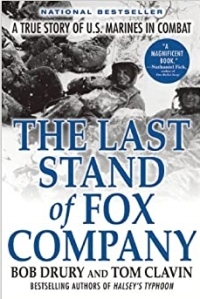 I’m fairly sure I’ve read all of Jeff Shaara’s novels from his two novels about Gettysburg up to his novel about the Korean War The Frozen Hours. Before I read it, I had already included a backstory about two characters in my Florida Folk Magic Series that included service in the 1st Marine Division in Korea. Since my work in progress, Pollyanna Hoskins includes these characters, I’ve placed one of them with Fox Company tasked with guarding a strategic pass.
I’m fairly sure I’ve read all of Jeff Shaara’s novels from his two novels about Gettysburg up to his novel about the Korean War The Frozen Hours. Before I read it, I had already included a backstory about two characters in my Florida Folk Magic Series that included service in the 1st Marine Division in Korea. Since my work in progress, Pollyanna Hoskins includes these characters, I’ve placed one of them with Fox Company tasked with guarding a strategic pass.
Here we have 234 marines holding off 10,000 Chinese soldiers. This is mentioned, of course, in Shaara’s book that covers the entire war. I wanted more specific information about the brave and determined men of Fox Company. There’s plenty of information online, but The Last Stand of Fox Company is very specific about Captain Barber’s three platoons and how they faired day by day against a vastly superior force in a harsh Korean winter when the temperatures were -34 °. While water and food and feet were frozen, the low temperatures saved some of the wounded whose wounds were frozen, keeping them from bleeding to death.
The entire campaign around the Chosin Reservoir in North Korea is called “frozen Chosin” for a reason.
Using the terminology of the day, my character is still “shook” in his life in the years after the war. “Shook” meant “to go mental,” later described as shell shock and then PTSD. After reading the account of Fox Company’s defense of a major road at Toktong Pass, I’d expect all of them, the few left standing to be shook.
From the PublisherNovember 1950, the Korean Peninsula: After General MacArthur ignores Mao’s warnings and pushes his UN forces deep into North Korea, his 10,000 First Division Marines find themselves surrounded and hopelessly outnumbered by 100,000 Chinese soldiers near the Chosin Reservoir. Their only chance for survival is to fight their way south through the Toktong Pass, a narrow gorge that will need to be held open at all costs. The mission is handed to Captain William Barber and the 234 Marines of Fox Company, a courageous but undermanned unit of the First Marines. Barber and his men climb seven miles of frozen terrain to a rocky promontory overlooking the pass, where they will endure four days and five nights of nearly continuous Chinese attempts to take Fox Hill. Amid the relentless violence, three-quarters of Fox’s Marines are killed, wounded, or captured. Just when it looks like they will be overrun, Lt. Colonel Raymond Davis, a fearless Marine officer who is fighting south from Chosin, volunteers to lead a daring mission that will seek to cut a hole in the Chinese lines and relieve the men of Fox. This is a fast-paced and gripping account of heroism in the face of impossible odds.
 When I was in elementary school, I saw many headlines in the daily papers about the Korean War. Needless to say, I didn’t understand the big picture. But the war has fascinated me in part because it’s more or less forgotten. But, it occurred just a few years before my novel-in-progress Pollyanna Hoskins is set. So, one way I’m adding depth to my novel is by including characters who were in Korea, the man as a marine corporal, and the woman (Pollyanna) as a marine nurse serving in MASH units and field hospitals.
When I was in elementary school, I saw many headlines in the daily papers about the Korean War. Needless to say, I didn’t understand the big picture. But the war has fascinated me in part because it’s more or less forgotten. But, it occurred just a few years before my novel-in-progress Pollyanna Hoskins is set. So, one way I’m adding depth to my novel is by including characters who were in Korea, the man as a marine corporal, and the woman (Pollyanna) as a marine nurse serving in MASH units and field hospitals.
The title of Jeff Shaara’s book comes from a poem by one of the marines on Fox Hill:
The long nights. Too long.
Time stops, frozen in place.
I beg the frozen hours for the
Sunrise.
Too many many memories
Ice and Death
I’m ready to join my friends.
And so, I can’t help but include bits and pieces of this war, partly because the heroism there has been mostly forgotten and partly because it’s a major factor in the world where my characters lived in the early 1950s.
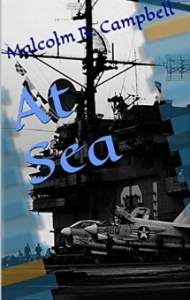 Malcolm R. Campbell is the author of the Vietnam War Novel “At Sea.”
Malcolm R. Campbell is the author of the Vietnam War Novel “At Sea.”

